Richardson and Boynton Co., Van Brundt between Imlay, Bowne and Commerce
Richardson & Boynton made stoves and furnaces. They were one of the biggest employers in Red Hook, Brooklyn from the mid 1800s until they moved to Dover, New Jersey in 1896.
There are several buildings on the 1869 map in the block between Imlay and Van Brunt Bowne and Commerce labeled Boynton works.
The 1880 map shows several buildings at the site that was later labeled Richardson & Boynton. It is not labeled at all on the 1880 map.
On the 1886 map of the area the buildings between Van Brunt, and Imlay, Bowne (not quite to) Commerce were labeled "The Richardson & Boynton Co. Stove Works"
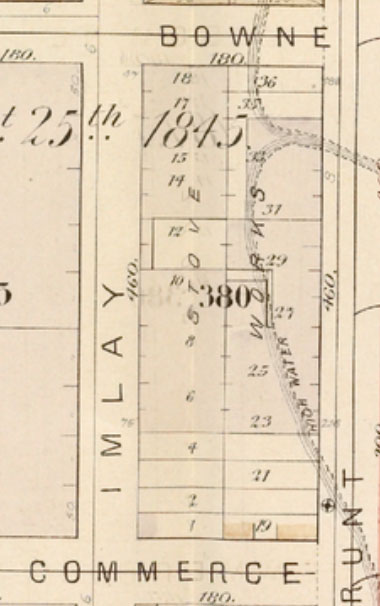
1880 map NYPL Digital collection
While not labeled as such, the pink buildings between Bowne, and Commerce, Imlay and Van Brunt were the location of Richardson and Boynton in 1880. The company was at that location from circa 1858.
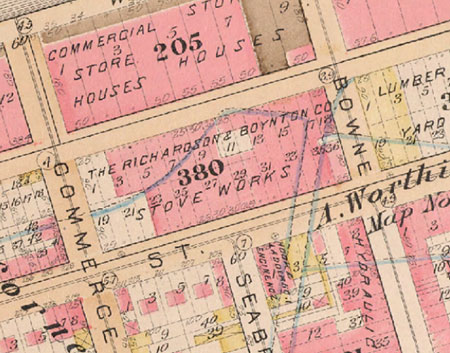
1886 map NYPL Digital collection
Additions were clearly made between 1880 and 1886. The red color of the structure indicates that it was constructed of brick.
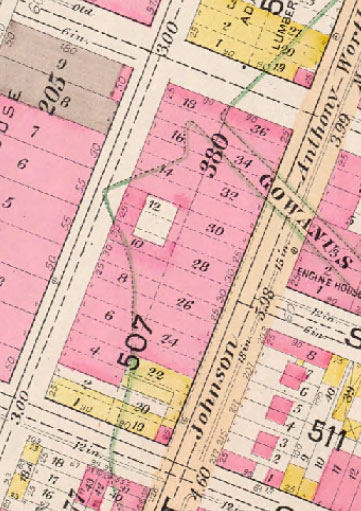
1898 map NYPL Digital collection
Richardson & Boynton left Red Hook in 1896, two years before this map was made. The brick structure is pretty much the same as indicated in 1886. The yellow indicates wood frame structures.
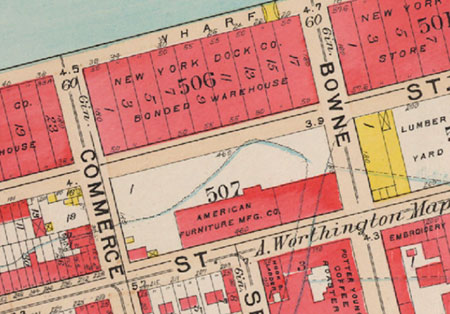
1907 map NYPL Digital collection
Over half of the 1886 brick structure was removed by 1907.
The 1916 map shows that even less of the building was still standing. There was a small section at the corner of Bowne and Van Brunt and a larger section along Van Brunt across from and south of Seabring.
Richardson and Boynton Co.
Richardson and Boynton Co., makers of stoves and heaters, was founded in Brooklyn in 1837. Their factory was located 186-226 Van Brunt (between Imlay and Van Brunt and Bowne and Commerce). They also had offices at 232 & 243 Water Street in Manhattan. At some point the had a foundry on Columbia street south of Lorraine.In 1857 Cox, Richardson and Boynton advertised "Boynton's Self-Cleaning Furnace "the most sucessful and safe heater in the market".
In 1896 William R. Adams, whose father had a lumber business at Van Brunt and "Bowen", reminisced that the large foundry of Richardson & Boynton was build circa 1858.
In 1868 Richardson and Boynton advertised a "calorific" Fire Place Heater.
1874: John Gaffney was arrested and accused by the plant superintendent, Mr. A. C. Lewis, of stealing $1 worth of steel from the plant of Richardson & Boynton Steel Works Van Brunt and Bowne streets.
1885: "WANTED first class foundry carpenter accustomed to bedding patterns and making flasks [?] for range and furnace woke; not others need apply, ready work, Richardson & Boynton, 200 Van Brunt."
1886: Carl Barlow, age 36, an employee of the Boynton & Richardson stove works at 200 Van Brunt, fell through a second story elevator hatchway and dislocated his shoulder.
In April 1887 Richardson and Boynton was involved in a controversy concerning a strike of pattern workers (the men who made the templates for machine parts). 225 men struck at the Richardson & Boynton stove works on Van Brunt street.
"In the shop of the Richardson & Boynton Company at Brooklyn the patterns were not laid down and the men remained at work."1886: February - Richardson & Boynton were building a two story brick stable on the south side of Commerce street, east of Van Brunt. The building was to be 41x37, costing $4,500. In addition to the second story hay loft, store room "etc. there was to be a dwelling consisting of a living room and four bed rooms....
"During the whole of Tuesday the patterns were not placed in the sand at Richardson & Boynton company's foundry"
In 1890 Richardson and Boynton advertised that they were manufacturers of furnaces, ranges, fire place heaters and stoves. Their furnace contained the "newest patterns" and the latest improvements to be adopted in a heating furnace.
1891: John Flood of 238 W. 15th street lost his right hand when it was cut off by a circular saw at Richardson & Boynton's stove works 200 Van Brunt.
1893: In April Timothy Hennessy, age 22 of 18 Woodhull street an employee of the Richardson & Boynton stove works at 200 Van Brunt, lost the toes of his left foot when a casting fell on them.
In 1893 the Richardson and Boynton stove works on Richard street laid off 432 men and shut their doors on June 31. It was customary to shut the works down for a week before and a week after July 4th so that repairs could be made to the furnace and the plant. There were rumors that they would either open on August 16th or not open at all.
In July 1893 the Tin and Sheet Iron Workers Union settled its "differences" with Richardson & Boynton who had not previously recognized organized labor.
By 1894 Richardson & Boynton made a "famous" double domed furnace.
1895: August - Richardson & Boynton of 186-226 Van Brunt with offices at 232 Water Street, New York announced plans to move its works to Dover, New Jersey.
In 1896 Richardson & Boynton employed 450-500 people at the Brooklyn factory where stoves, ranges, furnaces and heaters were manufactured. Most of the men were skilled workers; mechanics, moulders, machinists and iron works all receiving "high wages". The plant covered the entire double block between Van Brunt, Imlay, Commerce and Verona and covered over 80,000 square feet which included foundries and shops. The company owned this site and had been at this location for many years. At one time they also operated a huge frame shop on Columbia street below Lorraine (formerly Leonard). No large building is indicated on Columbia below Lorriane in the 1880 0r 1886 maps. On the 1886 map there is a frame building labeled "factory" on Bay street off Columbia (which is technically "below Lorraine" as Lorraine was two block further up Columbia).
One of the reason cited for the move to New Jersey was the increased cost of receiving the large quantities of raw materials (coal, coke, pig iron, moulding sand and clay) needed to tun the shop. A short while before a 5 cents a ton charge had been added to the boats wharfage costs.
The factory moved to Dover, New Jersey in February 1896. Reasons given were: lack of space at the Brooklyn facility, higher production costs and tax incentives offered by New Jersey.
"The change of the place of manufacture was brought about, it is said, by an offer of the authorities in Dover to guarantee to them the payment of their taxes for ten years........A large number of the employees of the company moved to New Jersey with the plant."In August 1897 the Brooklyn Wharf & Warehouse Company purchased the old Richardson & Boynton property on Van Brunt street. They planned to use it as a receiving and distributing station. The property was described as bounded by Van Brunt, Commerce, Imlay and Bowne streets. It had a mortgage of $60,000. It was said to be valued at $135,000
In February 1898 the Dover plant was out on a strike of 100 mounters who were demanding higher wages.
1898: Italian workmen, employed by Norton & Co. contractors, were digging in a cellar at 200 Van Brunt, the former location of the Richardson & Boynton stove works, when they found a small box containing human bones. It is unclear if they were children's or adult's.
In 1904 an article about Chesebrough leaving Red Hook stated that Richards and Boynton Stove Works, one of the largest concerns in Red Hook, had left for economic reasons.
"Beside the big plant that occupied two blocks on Van Brunt street, there was another big building in Columbia street, the foundry that is now occupied by a dealer in old metals."By 1911 there was a vacant lot at the site of the old Richardson & Boynton works between Imlay and Van Brunt, Commerce and Bowne streets.
In June 1914 the New York Times reported a $500,000 fire at Dover:
"All of the plant of the Richardson Boynton Company, except the shipping department building, was destroyed by fire today. The firm manufactured stoves and ranges, and its plant, which was Dover's largest industry, covered thirty acres of ground."The Dover plant, which employed 1,100 men, had been shut down three weeks before for repairs. The watchman said he first saw smoke in the trimming shop. Other witnesses said they saw flames at three or four different places at the same time. All the buildings were wood frame except the shipping department. The water pressure was inadequate to put out the fire and the fire spread quickly from building to building. There had been no fires or furnaces going in any of the buildings at the time and the engines had been "cold" since the shutdown. "Incendiarism" was suspected.At the time W. L. R. Lynd was both the Treasurer of the company and the mayor of Dover.
The Dover Historical Society reported in the fall of 2005, that by 1928 the company had moved most of their production to plants in Utica and Buffalo. The Dover plant was closed permanently in 1938 and in 1939 Richardson & Boynton filed for voluntary bankruptcy.
Many real estate ads made of point of mentioning that there was a Richard & Boynton furnace in the basement of the building for sale or rent.
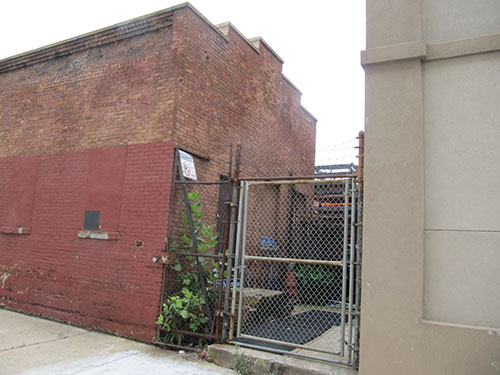
Maggie Land Blanck, September 2012
Between Bowne and Commerce on the east side of Imlay is a building that may be the remains of the Richardson and Boynton Co. However, the 1907 map does not show any building on the east side of Imlay between Bowne and Commerce.
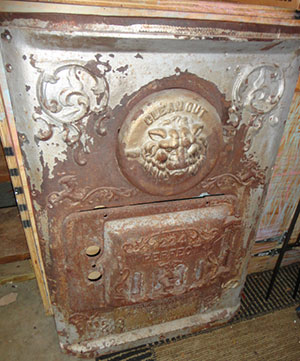
Ebay September 2012
Richardson and Boynton Co stove front
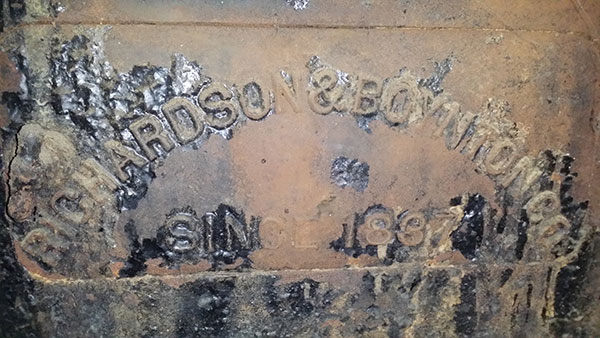
Courtesy of Kel Ros, January 2015
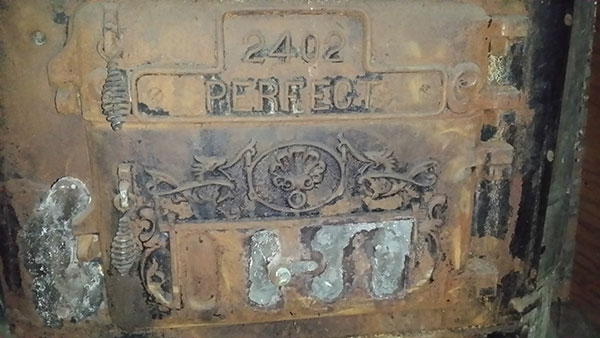
Curtesy of Kel Ros, January 2015
What Kel Ros found in his cellar in 2015.
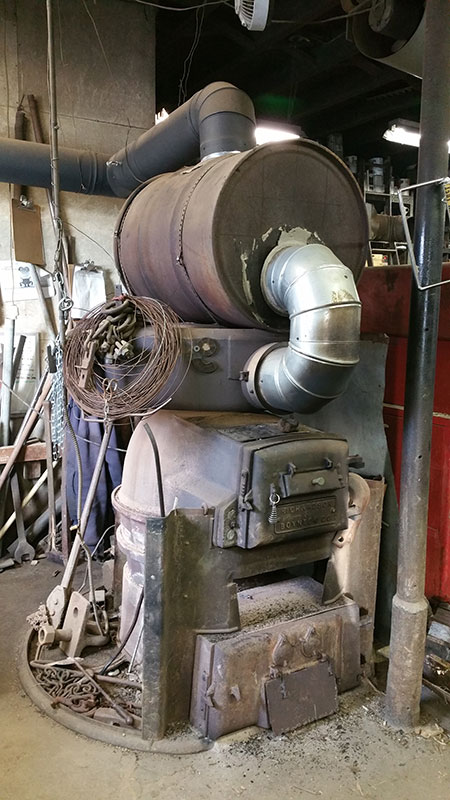
Curtesy of Jaret Segovia, February 2015
Keeping people warm on a farm on the East End of Long Island in February 2015
Nathaniel Augustus Boynton (1823-1900)
Henry A Richardson, Frederick B. Richardson and Augustus Phelps RichardsonBoynton, Nathaniel Augustus , died at his residence, No. 3 East 62d Street, this city, on the 10th of February, 1900. He was a descendant, in the 8th generation, of John Boynton; who, with his brother William, emigrated in 1638, from Yorkshire, Eng., to Rowley, Mass. Mr. Nathaniel A. Boynton was born in Mason, N. H., 12th of July, 1823, and was the eldest of the six children of Nathaniel and Eliza (Lawrence) Boynton. In 1824 the family removed to Shirley, Mass. His early education was in the common school, supplemented by a course at the Lawrence Academy, at Groton, Mass.; and continued and rounded out, during later life, by extensive foreign and home travel. His business life was commenced in Clinton, Mass.; but he soon found a larger field for his activities in Boston, where he became interested in the invention, production and sale of hot-air furnaces and other heating apparatus. About 1840 he removed to New York City, and became associated with Henry A. Richardson, in the Richardson & Boynton Co. About 1884 the Boynton Furnace Co. was organized, with Mr. Boynton as President, which office he continued to fill until his death. His first residence was in Brooklyn, where he was well known and largely identified with many of its highest local interests. He was there a trustee of the Brooklyn Children's Aid Society, a life-member of the Brooklyn Young Men's Christian Association, the Long Island Historical Society, the New England Society, of Brooklyn; the Congregational Club of New York, and the Brooklyn Institute of Arts and Sciences. After his removal of residence to New York City, about 1881, he joined the New England Society of New York; and this Society, of which he has been a member since March, 1894. Always interested in Church work, he was, while in Brooklyn, a deacon and trustee of the South Congregational Church, under the pastorship of Rev. Dr. A. J. Lyman; and in New York, a member of the West Presbyterian Church, of which Rev. Dr. A. H. Evans is pastor. As an inventor, Mr. Boynton ranked high and loved his work; and his name must ever be inseperably connected with the hot-air furnace system of heating. He had a broad mind, and a peculiarly genial manner; and was respected and beloved, both in the trade, and in many circles of friends. Mr. Boynton was twice married: (i)in 1845, to Asenath Bliss, of Brimfield, Mass., by whom he had three sons, George Augustus Boynton and Charles Bliss Boynton, of New York, and Frederick Lawrence Boynton, deceased. He married (2) Prudence Wilber Champlin (who survives him), daughter of Joseph and Delight and grandaughter of Jeffry Hazzard Champlin, of Rhinebeck-on-the Hudson. By this second marriage he had three daughters, Mrs. Edwin E. Dickinson and Mrs. S. A. Swenson, of this city, and Mrs. Jerrold W. Black, of Syracuse, N. Y.Marriage 1: Asenath BlissThe New York Genealogical and Biographical Record, Volume 31 By New York Genealogical and Biographical Society
Children:
Death of Asenath Bliss Boynton:
- George circa 1848
1870 Brooklyn, Ward 6, Iron broker age 22 with his parents
In 1880 he was listed in Brooklyn as an iron broker - wife Irene - two daughters Annie age 9 and Irene age 7
- Charles Bliss circa 1851
1880: Listed on Clinton street, born Mass. stoves and ranges - boarder - married - wife Emma age 24, son Nathaniel age 4
He was listed as the vice president of the Boynton co in 1884.
- Frederick born 1854 died as a infant
2 Apr 1822 Brimfield, Hampden County, Massachusetts, USA DEATH 4 Jul 1854 (aged 32) BURIAL Brimfield Cemetery Brimfield, Hampden County, Massachusetts, USA (Find a Grave)Marriage 2: Prudence Wilber ChamplinWife of Nathian Boynton died July 10, 1854 age 32 years - Frederick Lawrence their son died Feb 5, 1854 age 7 months and 13 days
Children:
- Frances circa 1856 - Married Edwin E Dickinson
1900: Manhattan - West 77th street, Edwin E Dickinson 46, Francis B Dickinson 43, Delight Dickinson 15, Wells S Dickinson 14, Edwin B Dickinson 7
E E Dickinson was the secratary treasurer of Boynton and Co. in 1884
- Delight circa 1858 - Married Jerrold W. Black
J. William Black Spouse's Name Delight Boynton Event Date 20 Jan 1898 Event Place Manhattan, New York, New York Father's Name Abram Black Mother's Name Harriet Schuyler Spouse's Father's Name N. A. Boynton Spouse's Mother's Name Prudence W. Champlin
- Mary circa 1862
Marriage: Swen Albin Swenson Spouse's Name Mary Prudence Boynton Event Date 11 Apr 1883 Event Place Manhattan, New York, New York Father's Name Swante M. Swenson Mother's Name Susan Mcrady Spouse's Father's Name Nathaniel A. Boynton Spouse's Mother's Name Prudence W. Champlin
1850: Boston Massachusetts - Nathaniel A Boynton 27, stoves, Asenath B Boynton 28, George A Boynton 2, Mary Slattery 20 Ireland
1865: Brooklyn Nathaniel A 42, stoves and ranges, born NY, Prudence W Boynton 32, wife, George A Boynton 17, born Mass., Charles B Boynton 14, born Mass., Frances A Boynton 9, born NY, Delight Boynton 7, born Westchester, Mary Boynton 3, born Westchester
1870: Ward 6 Brooklyn Boynton, A. N. age 46, furnaces and ranges $21,000 $3,500 Prudence, wife 37 Charles 20, Fannie 14, Delight, 12, Mary 8, George 22 iron broker and two female Irish servants.
1880: 74 1st place, Nath. A. Boynton 55, merchant, Prudence W. Boynton 47 Fanny Boynton 23 Delight Boynton 22, and two servants.
1881: Heating Apparatus, Nathaniel A Boynton 196 Van Brunt Publication Title: Brooklyn, New York, City Directory, 1881
1881: Nathaniel A Boynton 200 Van Brunt Furnaces, home 74 First Place, Publication Title: Brooklyn, New York, City Directory, 1881
He got several patents for heater and stove designs.
Buried Rhinebeck Cemetery with his second wife, Pruudence W. Champlin
David Rait Richardson,FEEDERICK B. RICHARDSON. Bro. Frederick B. Richardson has reached the pinnacle of his ambition in Freemasonry. The same push and energy and spirit of investigation that have always characterized him in his business efforts led him to pursue his journey from the ground floor of the Temple to the highest point attainable in the Order. He took his first step as an Entered Apprentice in Nassau Lodge No. 536, on June 29, 1886; he passed to the degree of Fellowcraft September 9th, and was raised to the Sublime Degree of a Master Mason Sept. 20, 1886. He affiliated with Altair Lodge in January, 1887. He was exalted a Royal Arch Mason in Constellation Chapter No. 209; explored the vaults of Cryptic Masonry in Brooklyn Council No. 4, R. & S. M.; was exalted and dubbed a Sir Knight in Clinton Commandery No. 14; thence in the Ancient Accepted Scottish Rite through Aurora Grata Lodge of Perfection, Oct. 8, 1886; Aurora Grata Council Princes of Jerusalem, Oct. 22, 1886; Aurora Grata Chapter Rose Croix, January 26,1887, and was made Sublime Prince of the Royal Secret, 32d degree, in New York Consistory February 20, 1881, and became a charter member of Aurora Grata Consistory at its organization; he crossed the burning sands in Kismet Temple, Ancient Arabic Order, Nobles of the Mystic Shrine; he holds a Life Membership in all these Bodies except that of Clinton Commandery.Bro. Frederick B., youngest brother of H. T. Richardson, of Altair Lodge, was born in Brooklyn, February 12, 1859. He was educated at the Polytechnic Institute, but left school at the age of seventeen to enter upon a business career with the firm of Richardson & Boynton, of which his father was a member; on the incorporation of the Richardson & Boynton Company, in 1882, he became its Secretary.
He made for himself an honorable record in the National Guard, having served five years, from 1877 to 1882, as a member of Company C, Twenty-third Eegiment. Two severe sunstrokes from exposure while on duty necessitated his resignation. He is a genial companion and has a wide circle of friends in Brooklyn. He is a member of Hamilton Club, of Peconic Council No. 631, Royal Arcanum; of Brooklyn Council No. 800, A. L. of H., and of the Northwestern Mason Aid Association.
Free Masonry in North America from the Colonial Period to the Beginning of ..., 1889
RICHARDSON, Augustus Phelps, vice president Richardson & Boynton Co.; b. New York, Dec. 22, 1855; s. of Henry A. and Harriet Delano (Bliss) Richardson; ed. in eastern schs.; m. Brooklyn, N.Y., Dec. 6, 1876, Jessie S. Spelman; children: Ethel L. (Mrs. R. J. Dunham), Adeline (Mrs. John K. Lyon). Howard. After leaving sch., 1874, en- tered Richardson & Boynton Co. (formerly Rich- ardson, Boynton & Co., established, 1837), mfrs. of furnaces, of which is now vice pres., also mgr. of the Chicago house. Republican. Presbyterian. Clubs: Chicago, Chicago Athletic, Mid-Day, South Shore Country. Residence: Blackstone Hotel. Of- fice: 171 W. Lake St.
THE BOOK OF CHICAGOANS
D. Rait Richardson retired president of Richardson and Boynton, manufacturers of heating and air conditioning equipment, died in Palm Beach Fla., May 1939. He was born in Brooklyn Sept 27, 1874. He was married to Stella Van Ander, daughter of the late William M Van Anden. Survived by two sons, Thomas and David Rait Richardson, Jr. (both were officers of the Richardson & Boynton company). He was also survived by a sister, Mrs. Joseph H Seaman.William L. R. Lynd
William L. R. Lynd was born in Albany, New York October 30, 1856 a descendant of an Englishman who came to America in 1698. He started learning the copper and tin smith trade in Albany when he was fourteen, serving a five year apprenticeship. In 1881 he joined the company of Richardson & Boynton in Brooklyn "remaining with that house through various changes in proprietorship". When the works moved to Dover, New Jersey, he became the superintendent. He married ella Louise Dennis of Albany in June 1878. The had seven children six daughters and a son, Roy Edward, born November 15, 1881.John J Benedict (1851-1921) and his brother Coleridge Hart BenedictInfo from Biographical and Genealogical History of Morris and Sussex ..., Volume 1
He was a chess player and superintendent of the Richards & Boynton company in December 1894.
John J. Benedict age 70, born Peekskill, New York, died in July 1921 at his home in Flatbush. He was a retired moulder who had worked for Richardson & Boynton for 35 years. Survived by two sons, John C and William and a brother Coleridge of dover, N. J. Buried Greenwood.Timothy J Quinlan (1863-1915)1870: Ward, 10, John R Benedict 46, forman in foundry, $6,000, $1,000, Jane Benedict 44, Augustus Benedict 24, foundry business, Charles Benedict 22, foundry business, John J Benedict 19, foundry business, Coleridge Benedict 10, at school, Sarah Mahurd 55, at home.
1875: Ward 10, John R Benedict 52, moulder forman, Jane C Benedict 52, Agustus Benedict 29, agent, Charles Benedict 26, moulder, John J Benedict 24, moulder, Coleridtch Benedict 15 school, Anny Dunne 16, servant
1880: 35 Second street, John J Benedict 29, iron molder, Mary E Benedict 24, John J Benedict 2, and a servant.
1900: Brooklyn Ward 29, East 4th street, John J Benedict 50, iron moulder, Mary E Benedict 44 John C Benedict 21, house painter, William A Benedict 19, plumber
John J Benedict was also listed in 1910, 1915, 1920 in Brooklyn.
The Iron Era, Dover, Morris county, April 21, 1899 "Coleridge H. Benedict is a foreman at the foundry at the stove works. He came to Dover from Brooklyn when the Richardson and Boynton Company moved.
Coleridge Benedict was listed in Dover New Jersey in the 1900, 1910, 1920, 1930 and 1940 censuses.
1900: Coleridge H Benedict 39, forman moulder, Jennie Benedict 39, Coleridge H Benedict 13, Thomas G Benedict 9, Margarite A Benedict 7, Beatrice L Benedict 1, Jane Benedict 49, mother
Coleridge Benedict, SSN: 142-09-0001, Last Residence: 07801 Dover, Morris, New Jersey, USA, BORN: 4 Oct 1886, Died: Jun 1971, State (Year) SSN issued: New Jersey (Before 1951)
Timothy J. Quinlan, age 52, of 58 Flatbush ave, a molder by trade and a former employee of Richardson and Boynton, died of a cerebral hemorrhage. Born in Norwich, Conn he had lived in Brooklyn for 30 years. He was a dog fancier and breeder. Survived by his wife, Annie Hoar, a son Jeremiah J. and a daughter Mrs. Anna Smith of Newark, N. J., and a sister Mrs. T. J. Foley of Southington, Conn. Buried Holy Cross.1889: Timothy J Quinlan h. 1178 3rd ave., Brooklyn, New York, USA Occupation: Moulder Publication Title: Brooklyn, New York, City Directory, 1889
1892: Brooklyn, Ward 8, Quinlan, Tim, 30, iron moulder, James, 23, Alice 8, Jessie 6 Kate 4 John 1 a half, Annie 31
1894: Quinlan, Timothy, moulder h 166 50th
1900: Dover, New Jersey, Timothy J Quinlan 37, iron molder, Anna Quinlan 39, 6 children 3 living, Anna E Quinlan 15 Jermiah Quinlan 13 Catherine Quinlan 12, children born New Jersey, parents born Conn.
1905: Brooklyn, 49th street, Timothy Quinlan 43, molder iron, Annie Quinlan 43, Anna Smith 20, Jeremiah Quinlan 18, stenographer, Katherine Quinlan 17, ticket agent, Samuel Smith 21 son in law, stenographer.
1910: Brooklyn, Flatbush ave., Timothy Quinlan 49, proprietor birds and dogs store, Annie Quinlan 48 Jeremiah Quinlan 23, bird store
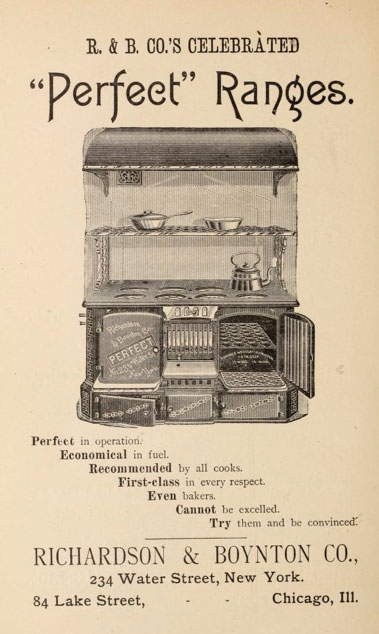
1887 Ad for a Richardson and Boynton Range.
Richardson and Boynton pioneered the four legged cooking range.
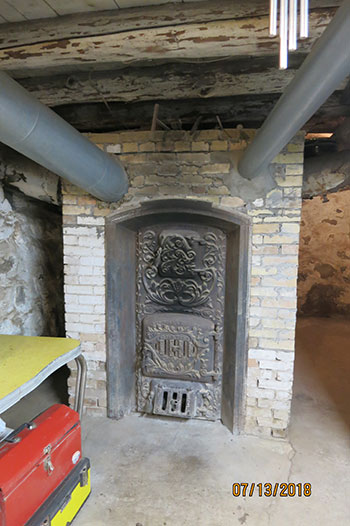
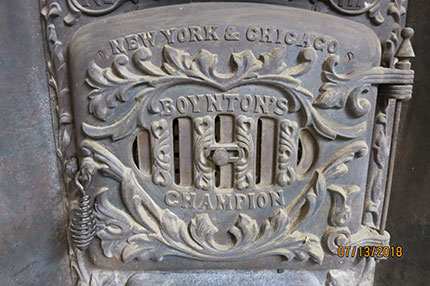
Another image Debbie shared was of a door embossed with: "Boynton Furnace Co. 207 & 209 Water Street New York"
1890: "207 & 209 Water Street, NEW YORK, 47 & 49 Dearborn Street, CHICAGO. Sole Manufacturers of Boynton's Furnaces, Hot-Water Heaters, Ranges, Baltimore Heaters, Etc. (American Architect and Architecture - Volumes 27-28)Boynton furnace company had offices on Water Street in Manhattan from at least 1882.
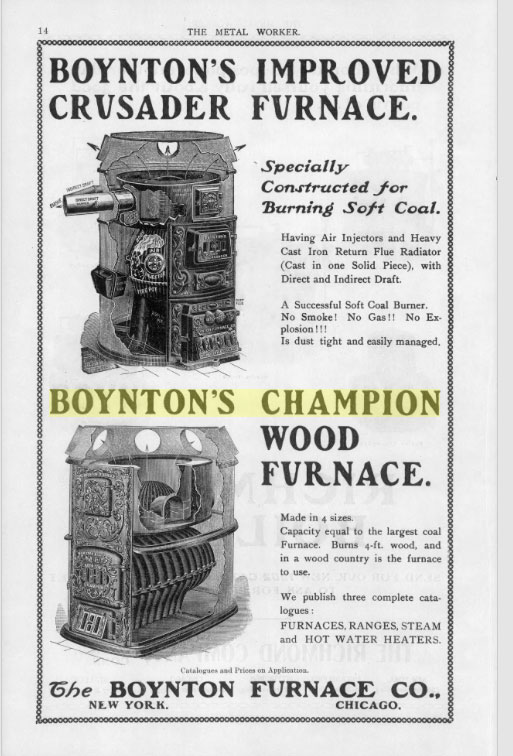
Sanitary and Heating Age, 1902
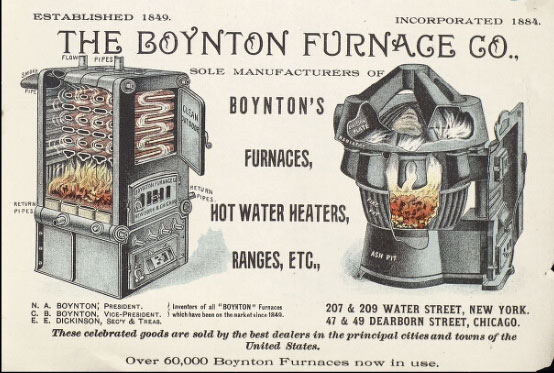
Ad in "A Present to you From Santa Claus - George A. Smathers Libraries - University of Florida Digital Collection
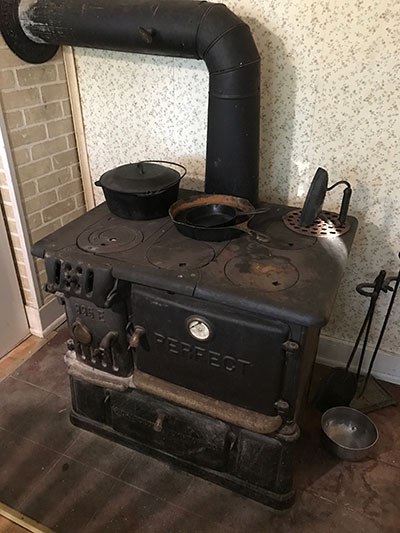
"This stove is currently in my parents' house in Babylon, NY. Still works!!!
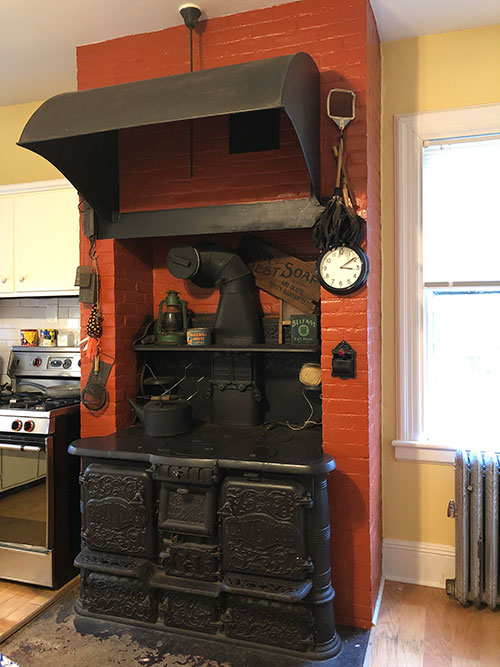
Jenny says the stove was original to her house in Greenwich, Ct. which was built in 1908. The stove still works but is not currently in use as the chimney has been damaged.
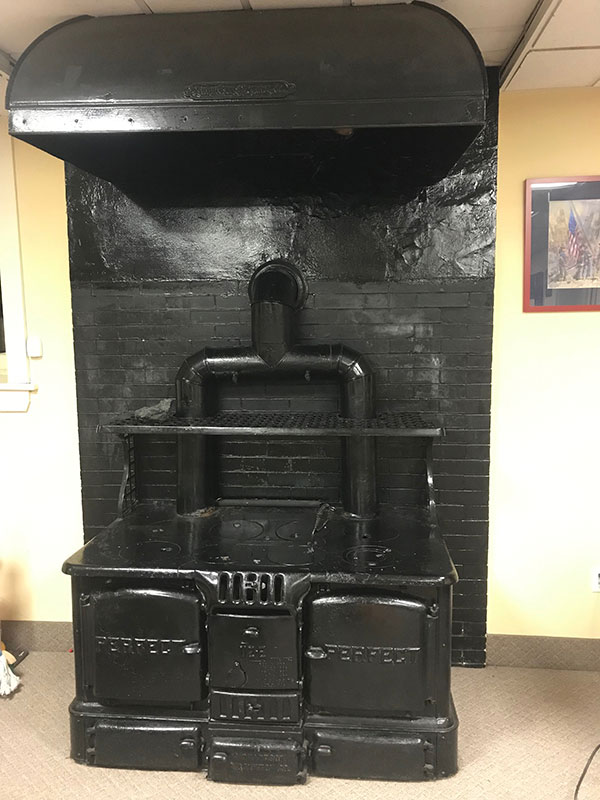
The original kitchen, including it's stove, was still in place, although no longer used, in the basement of our house when we bought it in 1994. So was the "stove" in the rough basement, which included bead board half walls to store the coal that came down shoots through the small, street level, basement windows. This small brick "stove" had an exhaust pipe that exited through a hole cut in the slate top and out the basement window, which is directly above it. Inside is just a big open space. No shelves, etc.
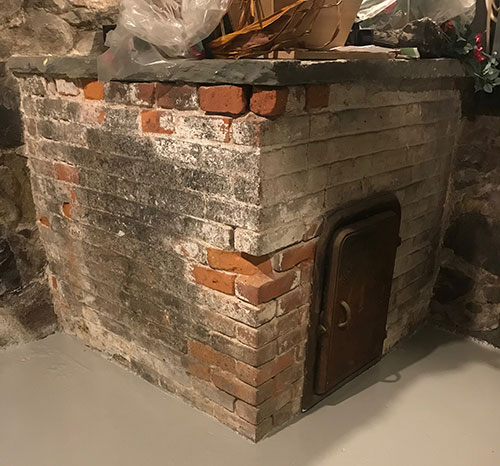
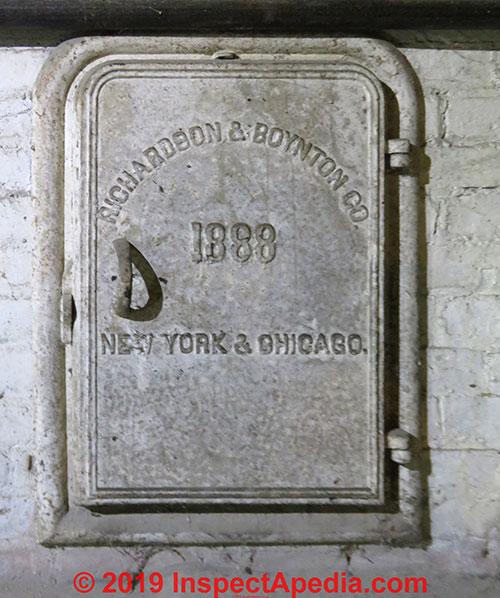
"A chimney cleanout from Richardson & Boynton Co. - the home is a Vassar College property currently under restoration and re-purposing, located at 79 Raymond Ave, Poughkeepsie NY" - Information and image shared by Daniel Friedman InspectAPedia November 2019.
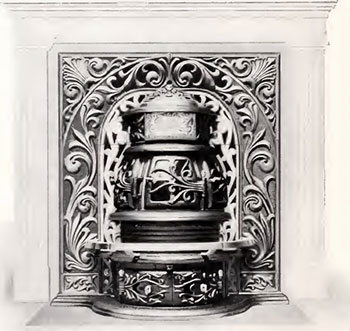
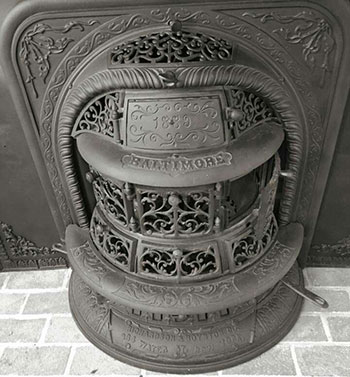
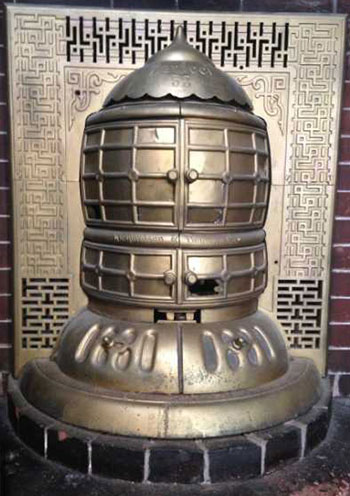
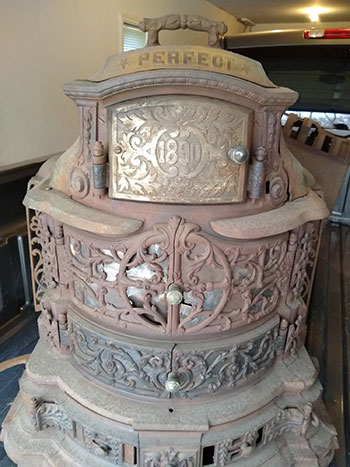
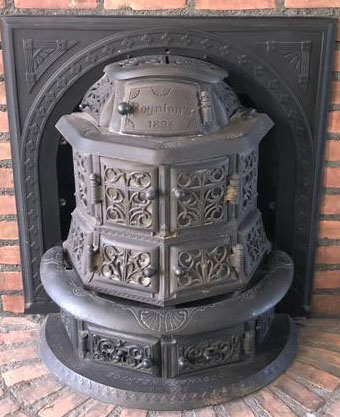
India Wharf Brewery
Sugar Refineries at India Wharf
Worthington Hydraulic Works
Red Hook
Liquor Stores Red Hood 1870 and later
Red Hood Industry mid to late 1800s
Life in Red Hood mid to late 1800s
HOME - FRITZ KETTLER - HANNA PETERS - JOHANN BEREND PETERMANN - IMMIGRATION